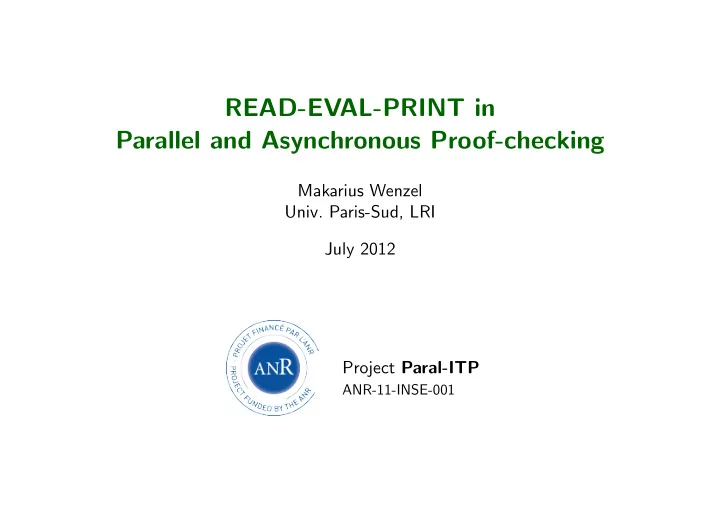

READ-EVAL-PRINT in Parallel and Asynchronous Proof-checking Makarius Wenzel Univ. Paris-Sud, LRI July 2012 Project Paral-ITP ANR-11-INSE-001
Introduction
Motivation Renovation of LCF-style theorem proving: • overcome sequential-synchronous TTY mode • overcome Emacs and Emacs LISP • extend parallel Isabelle/ML into the Scala/JVM world • facilitate integration of ITP systems into plain editors → Isabelle/jEdit as Prover IDE − Transfer of concepts and implementation: • help other provers to join the movement • encourage front-end applications within Prover IDE Introduction 2
Example $ISABELLE_HOME/src/HOL/Unix/Unix.thy Observations: • continuous editing can have non-local effects on prover commands • special care is required for parallel evaluation, with local forks and global joins (not shown here; disabled in current production version Isabelle2012) Introduction 3
Classic REPL architecture (from LISP) READ: internalize input (parsing) EVAL: run command (toplevel state update + optional messages) PRINT: externalize output (pretty printing) LOOP: emit prompt + flush output; continue until terminated Notes: • prompt incurs full synchronization between input/output (tight loop with full round-trip: slow) • errors during READ-EVAL-PRINT may loose synchronization • interrupts often undefined: might be treated like error or not → Proof General sometimes needs manual “repair” of protocol Introduction 4
Command Transactions Isolated commands: • “small” toplevel state st : Toplevel . state • command transaction tr as partial function over st → tr st ′ for st ′ = tr st we write st − • general structure: tr = read ; eval ; print (for example tr = intern ; run ; extern in LISP) Interaction view: tr st = let eval = read src in — read does not use st let ( print , st ′ ) = eval st in — main transaction let () = print () in st ′ — print does not update st ′ Note: flexibility in separating read ; eval ; print Introduction 5
Document Structure Traditional structure: • local body: linear sequence of command spans • global outline: directed acyclic graph (DAG) of theories Notes: • in theory: document consists single linear sequence → tr ′ st ′′ . . . → tr st ′ − st − • in practice: independent paths in graph important for parallelism Approach: • incremental editing of command sequences • parallel scheduling of resulting R-E-P phases • continuous processing while the user is editing Introduction 6
Document model Version history: • “big” document state state : Document . state • each version contains full document structure + evaluation state • document operations update versions in purely functional manner Document . init : Document . state Document . update : version-id → version-id → edit ∗ → Document . state → Document . state Document . remove-versions : version-id ∗ → Document . state → Document . state → main protocol operations on document-oriented proof processing Introduction 7
READ-EVAL-PRINT revisited
Prover Syntax: READ Characteristics: • many syntax layers ( ≈ 12 in Isabelle) • some syntax layers computationally complete (not really “syntax”) • solution for IDE document content: see [Wenzel, CICM 2012] • solution for interaction model: restrict to outer syntax (command spans corresponding to transactions boundaries) Scheduling: READ vs. remaining EVAL ↓ read ↓ read . . . → eval → eval st ′ st ′′ st − − . . . • potentially parallel read (independent of st ) • total read (syntax errors postponed to eval ) • further tuning via command internalization before applying edits READ-EVAL-PRINT revisited 9
Managed Evaluation: EVAL Standard model of SML + x − y : • strict functional evaluation, without global side-effects • program exceptions • physical exceptions (interrupts) • potentially non-terminating, but interruptible Portfolio of parallel Isabelle/ML: • type ’a future — value-oriented parallelism; strict evaluation with exceptions and cancellation; groups and dependencies • type ’a promise — externally fulfilled futures • type ’a lazy — non-strict lazy evaluation conforming to paral- lelism and interrupts (non-persistent) • type ’a memo — low-level memo-cells for raw execution with persistent interrupts READ-EVAL-PRINT revisited 10
Prover Output: PRINT Characteristics: • PRINT basically dual to READ • PRINT often more time-consuming than EVAL • assume total terminating PRINT, errors internalized into output • all output decorated by command transaction id Scheduling: READ vs. EVAL vs. PRINT ↓ read ↓ read . . . → eval → eval st ′ st ′′ st − − . . . ↓ print ↓ print . . . • potentially parallel print , e.g. lazy � future via perspective • not yet: potentially diverging and interruptible print operations → Asynchronous Agents Framework for Sledgehammer, Nitpick, etc. READ-EVAL-PRINT revisited 11
Protocol Interpreter: breaking up LOOP Main reforms: • dedicated protocol thread (uninterruptible) • private input and output stream, not stdin/stdout/stderr • undirectional stream processing without synchronization (delayed flushing of output) • protocol commands total, terminating, quick (max. 10–100 ms) • representation of protocol data via YXML/XML/ML encoding (simple, robust, efficient) Notes: • prover commands are data of the protocol • errors and interrupts are internalized — no POSIX signals between parallel processes READ-EVAL-PRINT revisited 12
Conclusion
Lessons Learned • READ and PRINT phases consume considerable runtime in prac- tice and require extra organization • EVAL opens a broad range of concepts for managed evaluation, independently of user-interfaces (initial motivation for the project) • LOOP is a genuine artifact of TTY interaction, replaced by protocol interpreter threads in ML and Scala • parallel evaluation + asynchronous interaction is very delicate (5 years until quite stable Isabelle2012, but still not finished) • making proof-of-concept implementation for Coq is very easy (5 days for some experiment in June 2012, including full protocol stack, excluding READ-EVAL-PRINT management) Conclusion 14
Further work • generalize PRINT to Asynchronous Agents Framework (e.g. Sledgehammer, Nitpick, Quickcheck in Isabelle) • full parallelism with local forks and global join as in Isabelle batch mode, including forked sub-proofs • encourage other prover people to join the movement away from TTY loop Conclusion 15
Recommend
More recommend